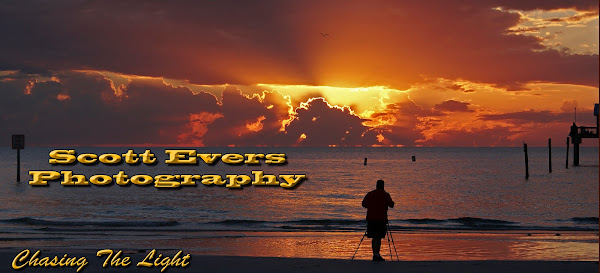 There are always certain types of photos that we love and are drawn to. Personally I have always loved the sunsets over the ocean with a fishing pier in them. Many people would say they are cliché type post card shots, but I don't care. When people see the photographs I do of them, they love them. I sell quite a few prints of them. I also do them in note cards that are also quite popular. Having been born and raised in the mid-west, I only saw the oceans when I went on vacation. Fortunately my parents loved to travel and we always took some great vacations. If I would win the lottery someday, I would split my time between a home on a tropical beach, and a small ranch out west somewhere in the mountains.
There are always certain types of photos that we love and are drawn to. Personally I have always loved the sunsets over the ocean with a fishing pier in them. Many people would say they are cliché type post card shots, but I don't care. When people see the photographs I do of them, they love them. I sell quite a few prints of them. I also do them in note cards that are also quite popular. Having been born and raised in the mid-west, I only saw the oceans when I went on vacation. Fortunately my parents loved to travel and we always took some great vacations. If I would win the lottery someday, I would split my time between a home on a tropical beach, and a small ranch out west somewhere in the mountains. Hanging out on a beach and watching a glorious sunset into the ocean is truly a relaxing experience for me. What most people miss is the best part of the show. As soon as the sun slips below the horizon, most people take off thinking the best part is over. Actually some of the most beautiful light and colors start then. There is a window of time, usually 10-20 minutes, when the sunlight is reflecting back into the sky over the curve of the earth and lighting the underside of the clouds. That is when you see the most vivid colors in the sky. This also applies to the sunrise before the sun comes up over the horizon, but the time frame for the best colors is much shorter.
Doing this type of photography is not very difficult, it just requires a little planning, some patience, and some basic equipment. I will usually scout out the scene an hour or so before sunset to see the angle, and where the sun will be going below the horizon in relation to what I am going to use as my main subject. I think about what I want the composition to look like and I will take a couple test shots hand held to see how it will look. Then it is a matter of waiting until the right light.
These are long exposure shots so the camera needs to be on a sturdy tripod. I use an electronic shutter release to trip the shutter. If you do not have a shutter release cable, you can use your camera's self timer to trip the shutter so you are not in contact with the camera. You want to avoid introducing any type of possible vibrations that might cause blurring. Since these are usually pretty long exposures, I do not use the mirror lockup feature like I would doing macro photography. I usually use the camera's evaluative metering system on the first shot and look at the results on the back of the camera. I usually then have to make adjustments depending on how the histogram looks. I either switch to manual mode and bracket the exposures, or I just use exposure compensation if it does not need much correction.
This last photo was not a sunset photo. This is a shot of the Sanibel Island Fishing Pier and Lighthouse taken about 15 minutes after the sun had set behind me. I wanted to catch the twilight night sky which is the blue to purple colors you get before the black night sky. Long exposures also tend to give everything a strong blue color cast anyway. This was shot from the causeway back to the mainland. I used a 500mm telephoto with a 1.4 extender to give me 700mm of focal length. This was about a 30 second exposure. I thought it made a unique looking photograph.





No comments:
Post a Comment